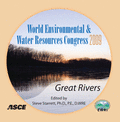Combining Rule-Based Fuzzy Model with GIS to Predict Groundwater Vulnerability to Contamination
Publication: World Environmental and Water Resources Congress 2009: Great Rivers
Abstract
The groundwater is the major natural resources for drinking and other various purposes; however, it is under threat of degradation of its quality from concentrated and/or dispersed sources of contamination in urban area of developing countries. Therefore, contamination of groundwater has become a major concern of decision makers and water managers involved with the management of water quantity and quality and their relationship to human health in recent years. Since, groundwater monitoring and mathematical modeling is very costly in regional scale vulnerability assessment, one frequently used water quality protection strategy is to develop contamination potential maps of groundwater, and then prioritize those wells located in the potentially highly contaminated areas for testing of contaminants. However, generation of contamination potential maps is not an easy task due to lack of sufficient hydrogeologic database and inherent uncertainty. This procedure is usually carried out using GIS based overlay index method and process based model. DRASTIC model, a popular index method is used to assess groundwater vulnerability over the large geographical areas on the basis of general hydrogeological knowledge of the contaminant transport in aquifer media. DRASTIC index uses linear model to calculate the vulnerability index and the factors that influence the groundwater vulnerability must be divided into ranges and then be given ratings. This system is unable to describe a continuous transition from the easiest to be polluted to the most difficult to be polluted that is fuzzy nature of the groundwater vulnerability to contamination. Therefore, this paper aims to estimate the risk of an aquifer to be polluted from concentrated and/or dispersed sources which applies the ability of the fuzzy ruled-based system to cope with the modeling of a nonlinear system and presentation of the output of the fuzzy system in the framework of GIS. This may be possible to describe this concept with a set of linguistics rules in the form of "IF-THEN". This paper presents the fuzzy inference system benefiting from fuzzy engine and expert knowledge-based DRASTIC parameters for nonlinear mapping of the intrinsic groundwater vulnerability concept. The developed fuzzy model is applied to a shallow aquifer of Kathmandu Valley, Nepal and the result is compared with that of the DRASTIC model. This methodology has potential for facilitating groundwater vulnerability modeling at a regional scale and can be used for other regions, especially in the case of data scarcity, however, would require incorporation of appropriate input parameters and rule base suitable for the region.
Get full access to this article
View all available purchase options and get full access to this chapter.
Information & Authors
Information
Published In
Copyright
© 2009 American Society of Civil Engineers.
History
Published online: Apr 26, 2012
ASCE Technical Topics:
- Artificial intelligence and machine learning
- Computer programming
- Computing in civil engineering
- Environmental engineering
- Fuzzy logic
- Geographic information systems
- Geomatics
- Groundwater
- Groundwater management
- Groundwater pollution
- Infrastructure
- Infrastructure vulnerability
- Pollution
- Surveying methods
- Urban and regional development
- Water (by type)
- Water and water resources
- Water management
- Water pollution
- Water quality
- Water treatment
Authors
Metrics & Citations
Metrics
Citations
Download citation
If you have the appropriate software installed, you can download article citation data to the citation manager of your choice. Simply select your manager software from the list below and click Download.
